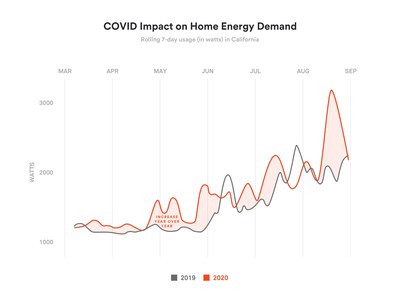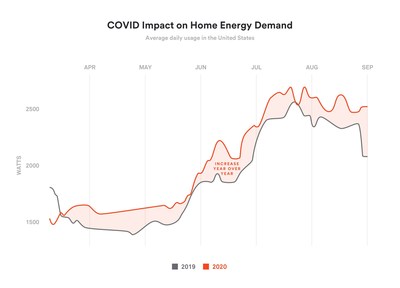Subject: SVY
Sense Data Shows Americans Paid Higher Electricity Bills in 2020, Impacted by Covid-19 Restrictions, Wildfires and Heat Waves
CAMBRIDGE, Mass., Jan. 19, 2021 /PRNewswire/ -- Based on an analysis of anonymized energy data in more than 5200 homes that have the Sense home energy monitor, Sense (sense.com) found that, since Covid-19, average electrical usage increased 9.3% from April through August 2020 compared to 2019, a reflection of people using more electricity while they stayed home, combined with wildfires in the west and heat waves across the country. With this increase, homeowners paid $85 more in the spring and summer months of 2020 compared to 2019. The average additional cost was trending to $127 per household by year's end.
Based on Sense's analysis, over the course of the spring and summer, U.S. consumers paid $1.21 billion additional on their monthly electricity bills in 2020 due to the combined impacts of the pandemic and climate change impacts. But the costs were not spread evenly across the country. In an analysis of five states with widely disparate responses to the Covid-19 pandemic, residents in Massachusetts and New York saw increases that were three times the increases in Florida.
As the coronavirus pandemic spread, electricity demand rose by 22% from March 10 to April 10 as people stayed home (see analysis here). In the following months, home electricity use remained higher than 2019.
Hit hard by Covid-19 in the spring, Massachusetts and New York residents paid the most
Two of the states that experienced the earliest Covid-19 surges and shutdowns, Massachusetts and New York, had the highest increases in electricity usage through the spring and summer. New York residents with the Sense home energy monitor used 12.7% more electricity compared to 2019, which translated into $27 more per month, and cost an additional $190.8 million statewide each month. By the end of the year, New Yorkers were trending to spend $243 extra in 2020, mostly related to Covid-19 impacts.
Massachusetts residents in the study saw 11.4% increases in their electricity usage and paid $27.20 more monthly, costing residents an additional $66.5 million statewide each month. With among the highest utility rates in the country, Massachusetts residents can expect to pay an additional $244.80 in 2020.
California's triple whammy: Covid-19, heat waves and wildfires
On March 19, California Governor Gavin Newson issued a statewide stay-at-home order, one of the first states to mandate the policy. During a late May heat wave, home electricity usage peaked at 21% higher than the previous year. In August, as hundreds of wildfires burned across the state and air quality fell to dangerously low levels, forcing residents indoors, electricity usage spiked yet again, by 16%. In fact, energy consumed during the end of the August heat wave was 31% higher than the highest week in 2019.
Over the course of spring and summer, California residents in the study paid $19.60 more monthly on average. By the end of the year, residents were trending to spend $176 more on their utility bills in 2020 compared to 2019.
Florida stays the course while Texas takes a middle road
In Florida, where the state didn't impose mask mandates in the spring, home energy usage spiked by 18.6% in March when the East Coast experienced the first wave of the pandemic but declined quickly. By summer, the electricity usage was close to 2019 levels. Overall, Florida residents used only 3.9% more electricity in the spring and summer for an additional monthly cost of just $8.40.
In July, Texas experienced record heat waves and a surge in coronavirus cases.1 Electricity bills increased by 12% compared to the previous July. Still, Texans averaged only 8.6% additional electricity use over the course of the spring and summer, which translated into $17.80 added to monthly bills. By the end of the year, Texans were trending to spend an additional $160 on their utility bills compared to 2019.
How People Can Get Help on Utility Bills
Early in the Covid-19 epidemic, many states issued moratoriums on utility shut-offs. Those moratoriums have ended in many states (see map) but utility customers may be helped by winter moratoriums, low-income energy assistance programs, or extended payment plans.
About Sense's analysis
Sense analyzed anonymized data for 5200 homes that have the Sense Home Energy Monitor between March 1 and August 31, 2020, that are geographically representative of the country. The analysis identified percentage increases in home electricity demand compared to the same dates in 2019. For trends in Massachusetts, New York, California, Florida and Texas, Sense analyzed anonymized data in 1823 homes in those five states.
About Sense
Sense's mission is to make all homes intelligent by keeping people informed about what's happening in their homes, and helping to make homes safer, more efficient, and more reliable. Founded in 2013 by pioneers in speech recognition, Sense uses machine learning technology to provide real-time insights on device behavior, even for those devices that are not "smart." Customers rely on Sense for a wide range of uses including monitoring their home appliances, determining whether they left appliances running and identifying how to reduce their energy costs. Sense has received investments from two of the world's largest energy technology companies, Schneider Electric and Landis + Gyr. Sense is headquartered in Cambridge, Mass. To make sense of your energy, visit: https://sense.com.
1. Source: texastribune.org/2020/10/20/texas-coronavirus-surge/
Media contact: [email protected]
SOURCE Sense
These press releases may also interest you
|
News published on and distributed by:






